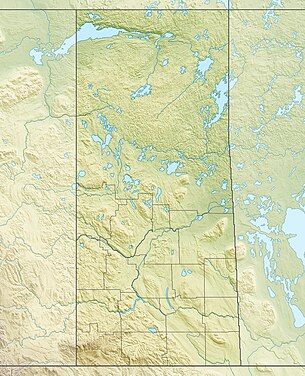| Battle of Loon Lake | |||||||
|---|---|---|---|---|---|---|---|
| Part of the North-West Rebellion | |||||||
| |||||||
| Belligerents | |||||||
| Cree |
| ||||||
| Commanders and leaders | |||||||
|
Big Bear Wandering Spirit | Sam Steele | ||||||
| Strength | |||||||
| 150 | 75 militia[1] | ||||||
| Casualties and losses | |||||||
|
5–12 dead 75-100 wounded at Loon Lake and Frenchman Butte |
7 wounded | ||||||
| Official name | Steele Narrows National Historic Site of Canada | ||||||
| Designated | 1950 | ||||||
The Battle of Loon Lake, also known as the Battle of Steele Narrows, concluded the North-West Rebellion on June 3, 1885, and was the last battle fought on Canadian soil. It was fought in what was then the District of Saskatchewan of the North-West Territories,[2] at what is now known as Steele Narrows at Makwa Lake, in Saskatchewan's Steele Narrows Provincial Park.[3] Steele Narrows[4] is a channel that separates Sanderson Bay from Makwa Lake.
Led by Major Sam Steele, a force of North-West Mounted Police, Alberta Mounted Rifles and Steele's Scouts (a body of mounted militia raised by Steele himself) caught up with and dispersed a band of Plains Cree warriors and their white and Métis hostages.
Cree scouts made a determined stand with what was left of their ammunition, but the body of the Cree column, realizing the hopelessness of their situation, released their prisoners and fled. The Cree casualties were four dead and dozens wounded.[5]
Wandering Spirit, the war chief leading the Cree military campaign, surrendered to authorities at Fort Pitt. Big Bear, the aging peacetime chief of this band of Cree, eluded capture until July 2.
- ^ William Bleasdell Cameron (1888), The war trail of Big Bear (p.207), Toronto: Ryerson Press (published 1926)
- ^ "Canadian Plains Research Center Mapping Division" (PDF). Retrieved September 13, 2013.
- ^ "Steele Narrows Provincial Park". Tourism Saskatchewan. Government of Saskatchewan. Retrieved September 18, 2022.
- ^ "Steele Narrows". Canadian Geographical Names Database. Government of Canada. Retrieved September 17, 2022.
- ^ "The Canadian Encyclopedia (Steele Narrows Battle)". Archived from the original on November 18, 2013. Retrieved November 18, 2013.
